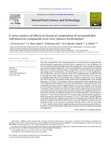
Please use this identifier to cite or link to this item:
http://ricaxcan.uaz.edu.mx/jspui/handle/20.500.11845/843Full metadata record
| DC Field | Value | Language |
|---|---|---|
| dc.contributor | 164375 | es_ES |
| dc.contributor.other | https://orcid.org/0000-0001-5894-2736 | - |
| dc.coverage.spatial | Global | es_ES |
| dc.creator | Klevenhusen, Fenja | - |
| dc.creator | Muro Reyes, Alberto | - |
| dc.creator | Khiaosa-Ard, R | - |
| dc.creator | Meztler-Zebeli, BU | - |
| dc.creator | Zebeli, Quendrim | - |
| dc.date.accessioned | 2019-03-22T20:57:57Z | - |
| dc.date.available | 2019-03-22T20:57:57Z | - |
| dc.date.issued | 2012 | - |
| dc.identifier | info:eu-repo/semantics/publishedVersion | es_ES |
| dc.identifier.issn | 0377-8401 | es_ES |
| dc.identifier.uri | http://localhost/xmlui/handle/20.500.11845/843 | - |
| dc.identifier.uri | https://doi.org/10.48779/jbv4-c636 | - |
| dc.description | This study examined the role of supplementation of several bioactive compounds (BC) and the chemical composition of the diet used as substrate for in vitro incubations, on in vitro ruminal fermentation profile and nutrient degradation. A meta-analytical approach was used to weigh the sample size used in each experiment, and account for the random effect of each as well as unequal variance among studies. A total of 20 recently conducted experiments with 354 treatments, each including one control (i.e., no BC supplementation), fulfilled the criteria for inclusion. Doses of BC supplementation varied from 0.03 to 500 mg/g dry matter (DM) of incubated diet. Contents of crude protein (CP) and neutral detergent fibre (NDF) of the incubated diets (DM basis) ranged from 139 to 189 g/kg and 160 to 420 g/kg, respectively. Results indicate that supplementation of BC linearly decreased (137.4 versus 116.5 mmol/L; P<0.05) concentration of total volatile fatty acids (VFA) and proportion of acetate (P<0.05). Also, the concentration of ammonia in the in vitro rumen fluid was lower with BC supplementation (22.9 versus 15.6 mg/dL; P<0.05). Analysis by backward elimination correlation analysis revealed that inclusion of the chemical composition of the incubated diet into the model with BC supplementation improved the accuracy of estimation of responses of fermentation variables. Thus, higher NDF and CP contents of the substrate and higher BC dosage were associated with lower concentrations of total VFA (r2 = 0.54), whereas both lower CP contents of the substrate and BC supplementation lowered the concentration of ammonia (r2 = 0.32). This analysis showed negative associations between BC supplementation and in vitro disappearance of DM and NDF, and positive correlations with dietary NDF content. In contrast, higher BC inclusion and lowering NDF content in the diet was accompanied with decreased in vitro CH4 formation (r2 = 0.21). Results indicate that BC supplementation and chemical composition of the incubated diet are determining factors which impact responses of in vitro ruminal fermentation and degradation. | es_ES |
| dc.description.abstract | This study examined the role of supplementation of several bioactive compounds (BC) and the chemical composition of the diet used as substrate for in vitro incubations, on in vitro ruminal fermentation profile and nutrient degradation. A meta-analytical approach was used to weigh the sample size used in each experiment, and account for the random effect of each as well as unequal variance among studies. A total of 20 recently conducted experiments with 354 treatments, each including one control (i.e., no BC supplementation), fulfilled the criteria for inclusion. Doses of BC supplementation varied from 0.03 to 500 mg/g dry matter (DM) of incubated diet. Contents of crude protein (CP) and neutral detergent fibre (NDF) of the incubated diets (DM basis) ranged from 139 to 189 g/kg and 160 to 420 g/kg, respectively. Results indicate that supplementation of BC linearly decreased (137.4 versus 116.5 mmol/L; P<0.05) concentration of total volatile fatty acids (VFA) and proportion of acetate (P<0.05). Also, the concentration of ammonia in the in vitro rumen fluid was lower with BC supplementation (22.9 versus 15.6 mg/dL; P<0.05). Analysis by backward elimination correlation analysis revealed that inclusion of the chemical composition of the incubated diet into the model with BC supplementation improved the accuracy of estimation of responses of fermentation variables. Thus, higher NDF and CP contents of the substrate and higher BC dosage were associated with lower concentrations of total VFA (r2 = 0.54), whereas both lower CP contents of the substrate and BC supplementation lowered the concentration of ammonia (r2 = 0.32). This analysis showed negative associations between BC supplementation and in vitro disappearance of DM and NDF, and positive correlations with dietary NDF content. In contrast, higher BC inclusion and lowering NDF content in the diet was accompanied with decreased in vitro CH4 formation (r2 = 0.21). Results indicate that BC supplementation and chemical composition of the incubated diet are determining factors which impact responses of in vitro ruminal fermentation and degradation. | es_ES |
| dc.language.iso | eng | es_ES |
| dc.publisher | ScienceDirect | es_ES |
| dc.relation | https://www.sciencedirect.com/science/article/pii/S0377840112002416 | es_ES |
| dc.relation.uri | generalPublic | es_ES |
| dc.rights | Atribución-NoComercial-CompartirIgual 3.0 Estados Unidos de América | * |
| dc.rights.uri | http://creativecommons.org/licenses/by-nc-sa/3.0/us/ | * |
| dc.source | Animal Feed Science and Technology Vol. 176, No. 1–4, 21 septiembre 2012, pp. 61-69 | es_ES |
| dc.subject.classification | CIENCIAS AGROPECUARIAS Y BIOTECNOLOGIA [6] | es_ES |
| dc.subject.other | Meta-analysis | es_ES |
| dc.subject.other | Essential oils | es_ES |
| dc.subject.other | In vitro rumen fermentation | es_ES |
| dc.subject.other | Volatile fatty acids | es_ES |
| dc.title | A meta-analysis of effects of chemical composition of incubated diet and bioactive compounds on in vitro ruminal fermentation | es_ES |
| dc.type | info:eu-repo/semantics/article | es_ES |
| Appears in Collections: | *Documentos Académicos*-- UA Veterinaría | |
Files in This Item:
| File | Description | Size | Format | |
|---|---|---|---|---|
| 11.- 2012 Klevenhusen et al., 2012.pdf | 276,41 kB | Adobe PDF |  View/Open |
This item is licensed under a Creative Commons License
